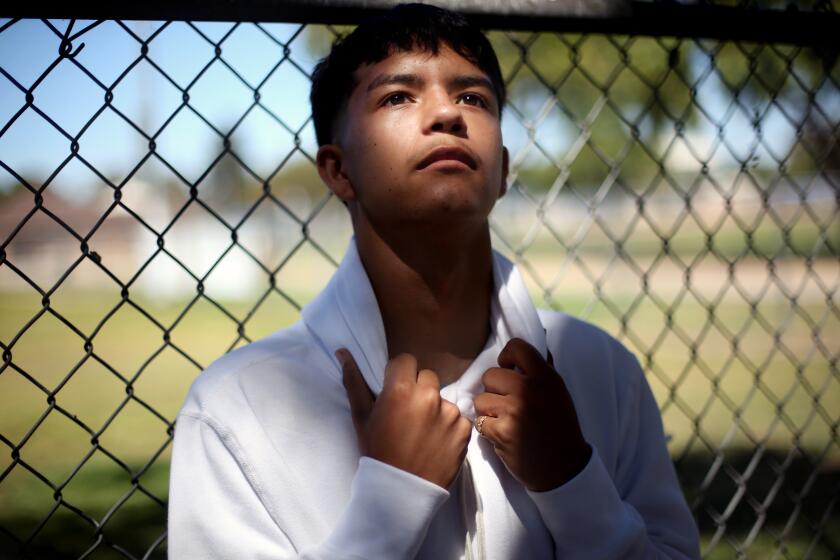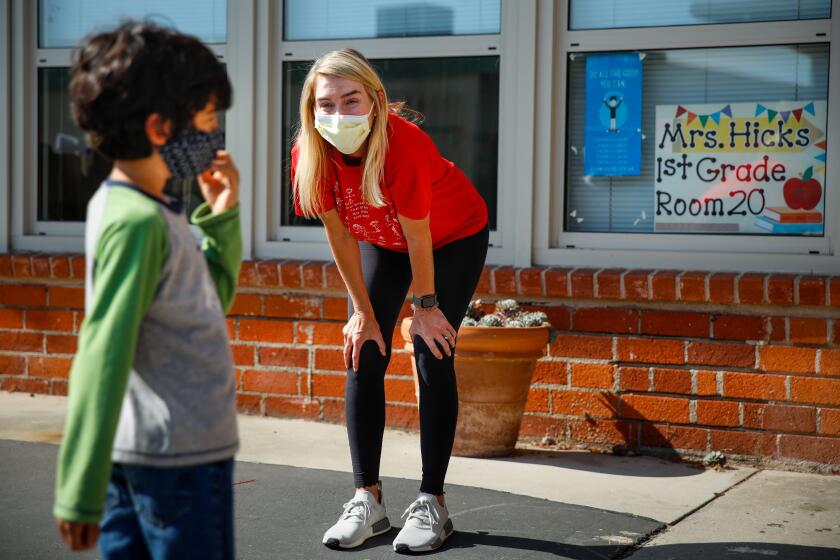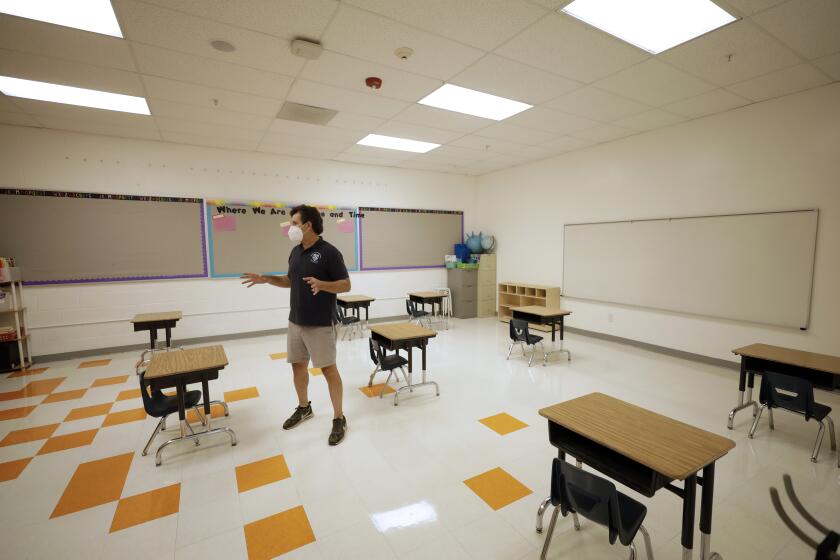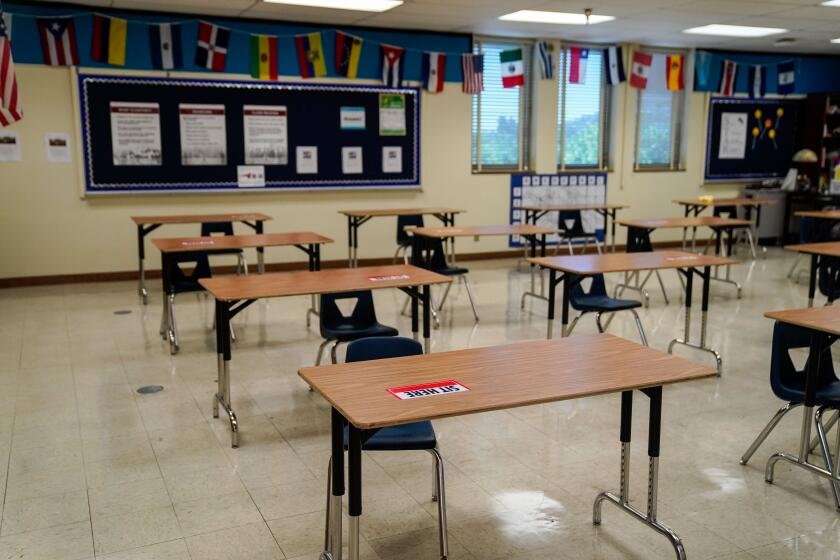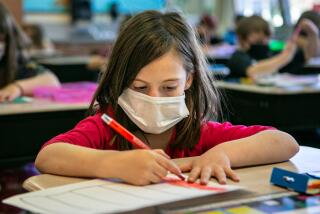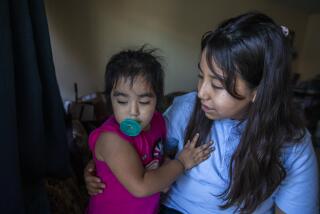Reopening elementary schools is risky — but so is keeping them closed
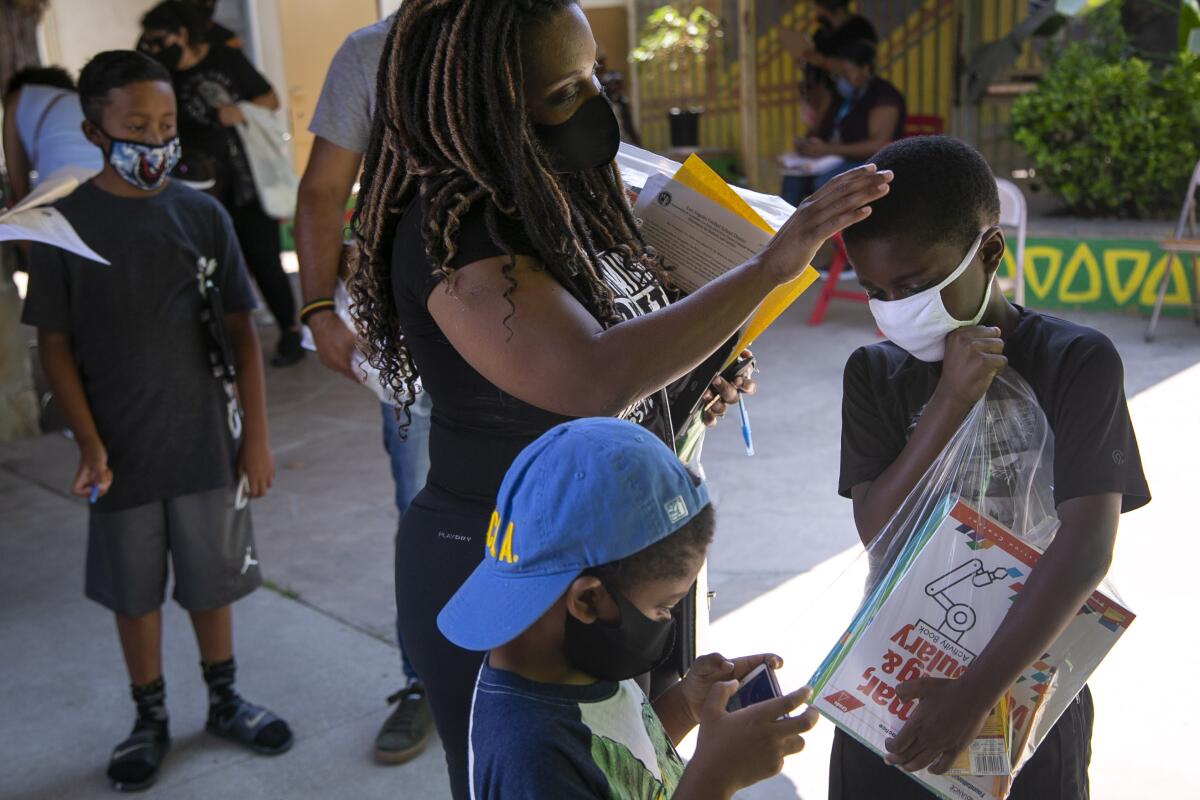
While the vast majority of California’s schools and universities are remaining closed to in-person instruction this fall, a small number of elementary schools are still hoping to reopen their doors in what will be a major test of how safe it is to begin in-person learning amid the COVID-19 pandemic.
California is generally not allowing schools to reopen in counties that have been on the state’s monitoring list for at least 14 days — and more than 88% of Californians live in counties on that list.
There are exceptions for elementary schools, however. Schools can request a waiver to the ban on reopenings, but to do so, coronavirus case rates must be under a certain threshold and the local health officer must approve the reopening plan, which requires consultation with the school’s staff and the state Department of Public Health.
It’s going to be a tough call to figure out how to get elementary schools reopened. Younger children are generally seen as being at lesser risk for COVID-19 than older children and adults. Still, reopening elementary schools when disease transmission is too high can be risky.
Questions about the availability of tests and contact tracing also are big factors. California is still struggling on both fronts, and that has some worried about how quickly officials can identify outbreaks and limit their spread. The Los Angeles Unified School District this week announced an ambitious testing plan for its nearly 500,000 students and 75,000 staff members, an effort intended to establish the baseline level of infection in the community, and eventually help determine when it is safe to reopen campuses.
Waiting too long to reopen schools — when it can be done in a more safe way — can have its own harmful effects.
Times survey finds profound disparities in distance learning between children attending schools in high-poverty areas and those in more affluent ones.
Not only does online-only learning worsen educational disparities for lower-income children, it also results in increasing anxiety and depression in both students and adults, higher levels of obesity, signs of increased child abuse and domestic violence, and job loss because of the need to care for children at home, said Dr. Naomi Bardach, a UC San Francisco pediatrician and associate professor of pediatrics and health policy.
But a path forward must be safe for both students and teachers. “It’s a false dichotomy to say that teachers and families are at odds,” Bardach said. “Openings cannot be done on the backs of the teachers and staff.”
Local conditions are perhaps the biggest factor in getting some schools reopened.
Some sparsely populated counties with few new cases have been allowed to reopen schools.
Shasta High School in Redding reopened for in-person instruction last week that keeps only half the population in classrooms at any time; students have in-person instruction two days a week and remote instruction the rest of the time. Shasta County is reporting 66 new coronavirus cases for every 100,000 of its residents over the last 14 days.
But Los Angeles County, a hot spot since the early months of the pandemic and on the state’s COVID-19 monitoring list, has more than quadruple the new case rate of Shasta County.
“We don’t want infections from the community coming back into our schools and creating an increase of outbreaks,” L.A. County public health director Barbara Ferrer said.
Interest is already building in some other counties for elementary school reopenings. Orange County has received at least 50 waiver applications. In Silicon Valley, most of the elementary schools interested in reopening were private schools, said Santa Clara County health officer Dr. Sara Cody.
There are a number of reasons why officials and experts say elementary schools are primed to reopen first.
Younger children are biologically less likely to contract COVID-19
The way the coronavirus enters the body’s cells is by latching itself on a specific kind of protein on the cell — the ACE2 receptor. The only way the virus can start injecting itself into the human body’s cells — to hijack it and start flooding the body with more copies of itself — is by latching itself on the ACE2 receptor proteins.
Younger children less than 10 years old have the fewest ACE2 receptors of any age group; adolescents, however, have more of them than younger children, but fewer than adults.
“Now, that’s a physiologic explanation for why there’s so few cases in children. It’s not like they’re none ... but it’s really underrepresented relative to their population,” said Dr. George Rutherford, epidemiologist and infectious diseases expert at UC San Francisco.
In California, children 5 to 17 make up about 8% of California’s coronavirus cases, despite comprising 17% of the state’s population. And of more than 11,500 Californians who have died after being sick with COVID-19, just one was under the age of 18 — a teenager who lived in the Central Valley.
Educators, health officials and scientists are still working to understand what it will take to make schools safe in the midst of the COVID-19 pandemic.
Based on other studies suggesting younger children are less likely to spread the virus to their families and older children, Rutherford said he suspects kindergarten to third grade students have a lower risk than older children.
There are also some practical reasons why children are less likely to transmit the virus, Bardach said:
- Younger children have smaller lungs, which means they emit smaller clouds of virus if they do sneeze or cough;
- Because they usually get less severe disease, there’s less coughing in general; and,
- Younger children are shorter than adults, meaning the virus-laden respiratory droplets children generate by talking, singing, sneezing or coughing are more likely to drop to the floor than to reach the height of an adult face.
“This suggests some practical advice for elementary and preschool teachers: generally, and especially for kids who may need comforting, keep your head above the child’s and position yourself on their side or towards their back rather than face-to-face,” Bardach said.
In fact, most children actually get infected with COVID-19 from someone in their household, according to studies from Chicago, Australia, China, Greece and Switzerland, Bardach said. It’s almost always the case that it’s an adult in the household who shows symptoms of COVID-19 first, and the child develops the illness afterward.
“We just don’t see transmission much from young children,” Rutherford said.
The difference with high school
High school students are a different matter. Studies showed that evidence of prior COVID-19 infection was much higher among students and teachers at a high school in Oise, France, than at about half a dozen local elementary schools. In fact, the prevalence of antibodies to the coronavirus at the elementary schools was essentially the same as that in the general community, Bardach said.
The reopening of schools in Israel is a clear lesson of how not to reopen schools.
Soon after the reopening after a two-month closure at a combined middle and high school in Jerusalem, the Ministry of Health suspended a mask-wearing policy for three days due to a heat wave, according to a study published in Eurosurveillance. Classes were crowded — with 35 to 38 students per class — and social distancing not possible between students and teachers, and air conditioning was used in the classrooms and the windows were shut.
The result was a mass COVID-19 transmission event. Twenty-five staff members and 153 students eventually tested positive for the coronavirus.
How you reopen also matters
The details of how venues for children reopen also matter. The California Department of Public Health requires schoolchildren in third grade through high school to wear face coverings, unless otherwise exempted, and strongly recommends the wearing of face masks among younger children up through the second grade.
An outbreak at an overnight camp in Georgia is also an example of what not to do.
The L.A. Unified School District opens online Tuesday. But the typical excitement is tempered by families’ anxiety and confusion as educators try to offer a ‘normal’ school day that is anything but amid the coronavirus.
At this camp, organizers did not require cloth masks for campers nor did they open windows and doors for increased ventilation, and attendees engaged in a variety of activities, including “daily vigorous singing and cheering,” activities that are known to easily spread the coronavirus.
“They sang — which is like the worst thing you can do,” Rutherford said.
At least 260 people at the camp tested positive, according to a study by Georgia and federal health officials.
But in San Francisco, a summer indoor camp for children between kindergarten and eighth grade found a successful way to operate without an outbreak, Bardach said, with the camp implementing masking, physical distancing, good ventilation and dividing up the children into groups that did not mix with one another, reducing the risk of a widespread outbreak.
None of the children were infected with the virus by the end of camp, Bardach said, and even the kindergartners were pretty good — if not perfect — at wearing masks. “The implication from this is it’s possible to follow public health principles ... and it can lead to limited or zero infections.”
But disease transmission levels need to be lowered
Officials, however, have started to come to a consensus that disease levels in hot spot zones still need to be lowered before elementary schools can reopen.
According to the U.S. Centers for Disease Control and Prevention, school reopenings internationally seem to be safe in communities with low coronavirus transmission rates. But when transmission rates are already high, reopening schools may further increase the risk of spreading disease, the CDC said.
L.A. County’s rate of new coronavirus infection is still too high.
In L.A. County, for instance, there have been 29,356 new cases reported in the last 14 days, which translates to a per capita rate of 291 new coronavirus cases for every 100,000 residents in the past two weeks.
L.A. County needs to get that number at 200 new cases per 100,000 residents to start contemplating allowing elementary schools to reopen through the waiver process, according to state rules. And L.A. County will need to get that number to 100 new cases per 100,000 residents for the last 14 days to get off the state’s monitoring list, allowing for the reopening of even more schools.
The experience at one junior high school in Indiana is sobering. A student came into the first day of classes hadn’t yet received the results of a coronavirus test but went to school anyway and was later found to be infected, forcing classmates to be sent home to be quarantined.
“You don’t want that start-stop-start-stop-start-stop kind of thing. That’s why we want to have incidence low in the communities from which these kids come,” Rutherford said.
Also important for the reopening of elementary schools seeking permission to reopen: the support and consultation among staff, unions and parent organizations, said Dr. Erica Pan, the California state epidemiologist.
“We need to get the community prevalence down in order to feel comfortable to reopen schools,” Bardach said. “We should make sure we prioritize reopening schools before reopening bars and restaurants. Reopening schools is a key piece to reopening our economy, allowing parents to return to work.”
Bars and restaurants don’t contribute to the economy at close to the same scale as having schools reopened, Bardach said.
Other risks
It’s understandable why people might be uneasy at the prospect of schools resuming, such as older teachers with underlying conditions.
And there remains the chance, albeit extremely rare, of the COVID-19 related multisystem inflammatory syndrome in children, in which a child exposed to the coronavirus can later experience their body parts becoming inflamed.
Bardach considers the inflammatory syndrome extremely rare. And there are treatments for this inflammatory syndrome, which is similar to a syndrome known as Kawasaki disease. “It’s such a lower risk than so many other things you just normally do in our daily lives that I would encourage people to feel less panicky about that particular syndrome,” Bardach said.
Reopening schools must also be vigilant about the risk of adults infecting other adults. An Australian study in the journal Lancet Child and Adolescent Health found that, in school settings, staff members were more than four times as likely to be infected by another employee than a child.
That means that schools should ensure that break rooms have adequate physical distancing and mask-on policies and avoid all in-person staff meetings.
“As we reopen schools, adult-to-adult transmission is where we should really be thinking about how to create ways of staying safe,” Bardach said.
The new school year of remote learning will bring unique challenges. Here are guides to help parents of school-age children navigate remote learning, as well as recent updates about education in Southern California.
More to Read
Sign up for Essential California
The most important California stories and recommendations in your inbox every morning.
You may occasionally receive promotional content from the Los Angeles Times.
